Bass Principles: An Interview With Joel Quarrington
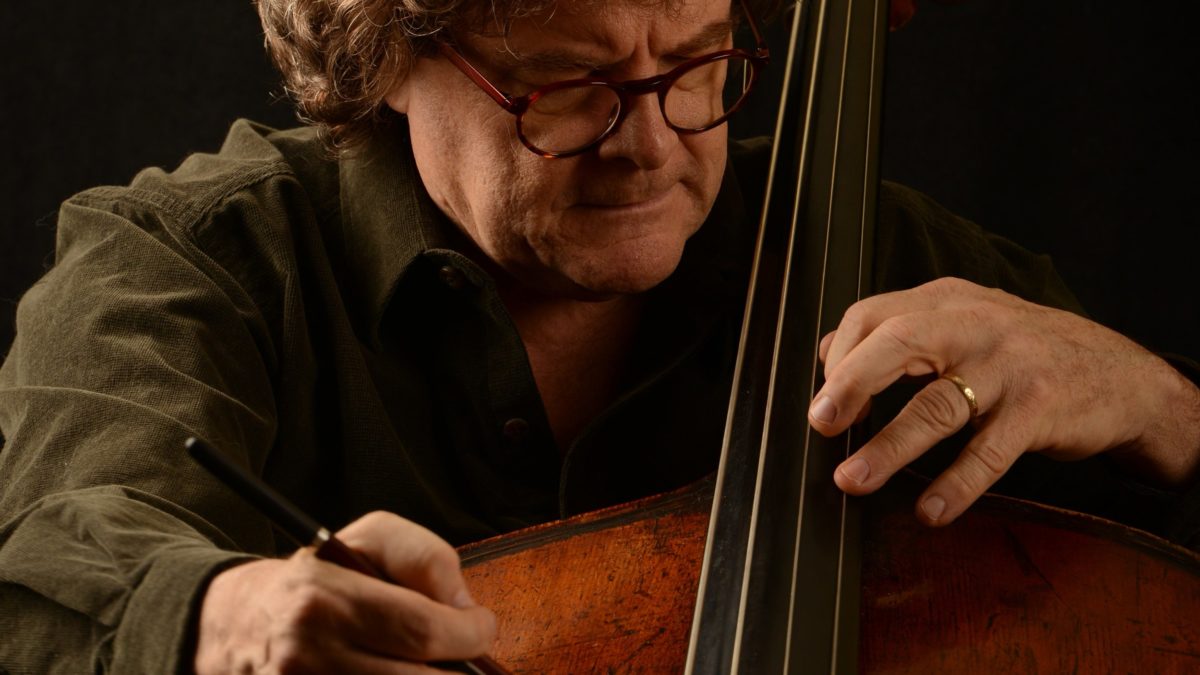
Joel Quarrington has been one of the world’s leading double bass players for over forty years, and though he retired from the National Arts Centre Orchestra last year, he’s not showing any signs of slowing down. The famed Canadian bassist, who has also held the principal bass chair for the Toronto Symphony and the London Symphony Orchestra, only seems to keep growing.
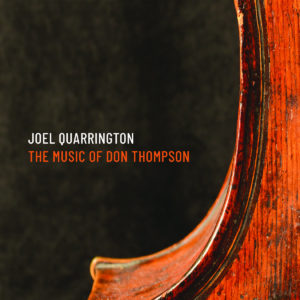 His latest album, The Music of Don Thompson, sees him dipping his toes into the jazz pool accompanied by the legendary pianist himself. The recording marks a departure from his classical repertoire by diving into the world of jazz ballads and Brazilian rhythms. Thompson wrote and arranged the music for the bassist, including a reworked piece for four basses he originally wrote in 1989. “Quartet 89” is completed by bassists Travis Harrison, Joseph Phillips, and Roberto Occhipinti.
His latest album, The Music of Don Thompson, sees him dipping his toes into the jazz pool accompanied by the legendary pianist himself. The recording marks a departure from his classical repertoire by diving into the world of jazz ballads and Brazilian rhythms. Thompson wrote and arranged the music for the bassist, including a reworked piece for four basses he originally wrote in 1989. “Quartet 89” is completed by bassists Travis Harrison, Joseph Phillips, and Roberto Occhipinti.
Quarrington creates his unique voice on the instrument by crafting his own approach. He is a leading proponent of tuning the bass in fifths, which he says leads to more accurate performance in all ranges of the bass as well as greater tonal richness. As such, his bass is tuned CGDA – one octave lower than a cello. His technical approach goes beyond the traditional methods, which led him to write a series of his own instructional books called The Canadian School of Double Bass. Quarrington’s instrument of choice is a historic Italian bass made in 1660 by Santo Maggini. Put this all together, and you have the recipe for some of the most beautiful bass playing you’ll ever hear.
In this wide-ranging interview, we talk about The Music of Don Thompson, The Canadian School of Double Bass, the pros and cons of being a principal bassist, and much more.
The Music of Don Thompson is available now on Bandcamp, iTunes, and Amazon MP3.
You met and began working with Don Thompson several decades ago. How did this album come about now?
Don was already an icon on the Canadian jazz scene when I was a young student. He played vibraphone, bass, piano, and drums all equally well. He was the bassist for the “Boss Brass” whose members were the best and most famous players in the city. I met Don when I made my first record, which was cello and bass duos with the cellist Coenraad Bloemendal, and Don was the producer. Coenraad was a friend of Don’s, and we recorded at Don’s studio, in his home. That was a special experience; not only meeting and working with Don but also an entirely new orbit of musicians, for instance, one time, I showed up at Don’s, and there was Joe Pass down in the basement! Also, through Don is how I got to know Red Mitchell. Red would phone me to talk fifths business whenever he was in town, and he would say that we were the executive board of the Fifths Tuning Club for Bass; he was President, and I was CEO!
A few years later, Don and I were both teaching at the Banff Centre, where Don headed up the jazz faculty. He must have told his guys I was ok because suddenly, I was friends with stars like Dave Holland, Kenny Wheeler, and Dave Liebman, who regaled me with stories of working with every famous bassist you could name.
Later still, I got to know Don as a pianist; I think we were rehearsing his Trio for piano, bass, and clarinet, and in a break, I curled up in a bass bag and went to sleep under a Steinway Grand piano. Don didn’t know I was there, and he started playing the most beautiful ballad-like music, with incredible chord changes that intermingled with my dreams. I promised myself then and there I would get him to write a piece for us to play together, and that turned out to be “A Nightingale Sang in Berkely Square.” Finding a home for that piece on a recording became a focal point for this recording as much as the bass quartet. Quartet ’89 was a piece Don wrote for us to play at Toronto’s “New Music Concerts” with Robert Aitken, director. The concert was called “Bass Bonanza” and featured a lot of solo contemporary works. The quartet calls for two classical players and two jazzers. We played with Wolfgang Guettler, from Berlin, who was at the vanguard of new music in Europe back in the day, and my good friend Roberto Occhipinti, who played the 3rd part. Roberto played with me in many orchestras when we were young, but nowadays wears many hats as a musician, composer, arranger, and producer, and is an internationally respected musician through his own recordings. Roberto has been the producer/editor of my last four CDs, including the Juno-winning “Garden Scene.”
In any case, during COVID, I was trying to move recordings from old cassette tapes onto my computer, and that concert was one of them; listening to the quartet (which, by the way, is very difficult!), I thought it would be great to have another go at it and try and do it justice. Roberto (who on this recording played Don’s solo 4th bass part) was also the owner of a great studio right in downtown Toronto with a nice grand piano, so it couldn’t have been more convenient. Don wrote more music for us to play, and it was really fun to hang around the studio and play with musicians once again after so many months of isolation. It was our coming out project, literally!
What is your preparation process for recording an album, and did it differ on this go around?
I try and prepare so that there will be the least amount of editing to do. However, I usually end up playing a piece many different ways when we actually start recording, and then I try to go with what is working best at the moment. In this case, Don was actually changing the whole feel of a piece sometimes as we went along, so being flexible turned out to be really important. For instance, the middle part of “A Quiet Place” was at first like a big band swing thing, and it became more and more not that, something much more gentle and understated. I might as well admit that Don wrote out all my music, I did nothing improvised. He wrote it out using exact rhythmic notation that looked very complicated, a bit like looking at Elliott Carter or something, but all he was trying to do was show the feel of the music, with some notes ahead or behind the beat. Initially, I took it too literally and had to be encouraged to loosen up. The square classical guy.
Much of the music on your newest album is a departure from your mostly classical catalog. Your phrasing perfectly fits the American Songbook and Brazilian styles of each song. How did you come to that, and what artists did you listen/look to in your approach?
I had in mind that I had to sound like a sultry, cool saxophone. I wanted the stylings of Vic Arpeggio but also the close intimate expression of Stan Getz where, to my ear, the breath and vibrato are mingled between notes, but the phrase never stops even through silence. I actually tried to use the same approach with a Schubert recording I made, but there, I tried to literally imitate a singer, especially how vibrato connects notes and perhaps how the bow can imitate different consonants as if the bass could actually play lyrics. As for the Brazilian feel… some of that was bloody tough! In 5/4 time, and everything is syncopated; all I knew was if I was on the beat, I was wrong! I loved it when Don used a broad triplet over two beats; I had to learn how to relax into that and just feel like I was gliding.
It’s so great to hear the four basses on “Quartet 89”. How did that song evolve since Don wrote it back then? How was it different performing it with this group?
I think we got things much tighter than previously, not only in our ensemble but all of us playing the same dynamics and articulations. This quartet was unique for me because everyone in the group, at one time or another, was a student of mine. Travis Harrison and Joe Phillips are both highly accomplished musicians in the orchestra, chamber music, and solo ventures. Joe is an award-winning player in multiple styles, and Travis is a great teacher; he is the co-author with me of the Canadian School of Double Bass books. These musicians have busy careers happening now, and it was really special to come together as colleagues and collaborators. I might have bossed them around a little. The studio owner, as I mentioned previously, was Roberto Occhipinti, who is my oldest friend; I taught him when we were both fourteen years old and for a dollar a lesson. After six lessons, I had literally taught him everything I knew and so I told him he had to go study with my teacher. He did and later said he wanted his money back.
Can you describe the concept behind the Canadian School of Double Bass and what you hope to achieve with it?
The goal is to learn to play with no effort. With balance and gravity, this is possible. Grabbing, squeezing, pressing and sudden angular flexing are all the biggest enemies of musicality. Loose rolling around and slow, relaxed flowing arms will do it all for you! The CSDB books are what I feel is a natural evolution for the left hand; less focus on the frame of the left hand as in Simandl, which to me means way too much rigidity and poor balance to close notes, and more about HOW it actually moves from note to note with the ease I mentioned earlier. Arriving on each finger with the optimum balance not only ensures good intonation without any shifting sounds but also the ability to vibrate. The pivot or rotation also gives spectacular rhythmic vitality and life to the hand.
You’ve been the principal bassist for several orchestras over the years, including the National Arts Centre Orchestra, from which you just retired. With some time away from the position, what are the highlights and difficulties of being the principal bassist?
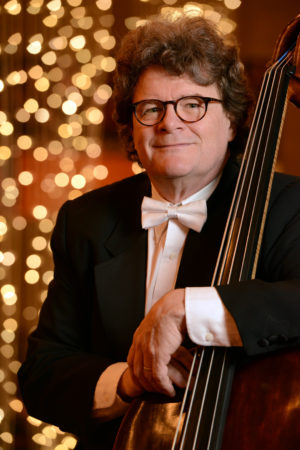 The highlights are playing the great symphonic works, especially by my favorite composers; Mahler, Bruckner, Beethoven, Brahms, Elgar, and Sibelius. Being part of a bass section that really puts out for these masterpieces is the best! I love it when the basses are absolutely tearing it up, giving everything they got; I try to encourage that as principal with how I play. I don’t say much; I don’t think people enjoy being told what to do. By the way, I dislike it when conductors talk too much. They should be able to show everything they want in their motions.
The highlights are playing the great symphonic works, especially by my favorite composers; Mahler, Bruckner, Beethoven, Brahms, Elgar, and Sibelius. Being part of a bass section that really puts out for these masterpieces is the best! I love it when the basses are absolutely tearing it up, giving everything they got; I try to encourage that as principal with how I play. I don’t say much; I don’t think people enjoy being told what to do. By the way, I dislike it when conductors talk too much. They should be able to show everything they want in their motions.
The difficulties of being principal are the same as for everyone else in an orchestra; different personalities have to work together and co-operate. The reality is that there are usually little feuds and politics brewing, and some people can hold onto that stuff for years and years. As a professional, you have to ignore all that and do your best for the sake of the compositions. The only thing I don’t miss about being principal bass is having to decide how to divide up “divisi” parts. It is amazing how complicated that can get when you have odd numbers to work with (3 parts into five players, four into 5 or 6, etc.), and I honestly don’t have a well-thought way of sorting it out. Every circumstance is so different; I think it should be the job of the assistant principal!
You have a magnificent Maggini bass. Can you tell us about its features? What is your favorite aspect of the bass?
My Maggini is a great bass and really unique! It is a thin body, but with huge Brescian arching, so it is actually quite deep. It is a 3/4 size bass, so it’s small and has a string length of 41 inches. I used it in orchestra all the time until I went to London and caught the bug about the deep and profound English basses. Now I can’t decide which I prefer for orchestral playing. I think players in the orchestra (not basses) hear me better with the Maggini, at least that’s what cello players tell me at least.
Much of the solo double bass repertoire that is studied and performed is a small pool of music. What are some of your favorite lesser-known pieces – old and new?
I like the Viennese concerti from Sperger, Zimmerman, and Hofmeister; I just received a huge stack of amazing Sperger concerti from Klaus Trumpf, and it is really wonderful music that should be known by everyone. I wish people would learn something besides Vanhal and Dittersdorf! Likewise, the repertoire of Bottesini has many underplayed gems like the 1st Concerto or his Beatrice de Tenda Fantasia. With a newer repertoire, there are lots to be excited about. Great sonatas by Hertl, Montag, and Weinberg, as well as concerti by Tubin and Andres Martin, which have now entered the mainstream of bass playing, I think. It is amazing how much new repertoire is being created, for the bass, from all over the world. My personal specialties are two concerti that were written for me by Raymond Luedeke and Peter Paul Koprowski. I have a lot of transcriptions in my repertoire, but I never get tired of playing the 1st Brahms Violin Sonata op. 78 in G.
What music has been exciting you lately?
I am really into Valentin Silvestrov; I recorded his Postude #3, which is on YouTube, and I am pretty happy with it. He is a remarkable composer, and I recommend people listen to his 5th Symphony if they like the Postlude. For enjoyment, I like to listen to Glenn Gould’s Goldberg Variations by Bach in the special Sony release that has everything from the 1955 sessions, so it takes maybe 6 or 7 hours to listen to the whole thing. Every take is a little different from the last, and it is fascinating to hear GG create so many different ways the piece could go.
Have you been able to perform much this year?
I have been back playing as Guest Principal at the National Arts Centre in recent months, and I had a very busy performance schedule in the summer, so I guess things have been pretty normal for me since last spring. I am not very retired at all.
With this album out, what are you currently working on that we can look forward to?
I am recording all the Bach Cello Suites as videos, and I practice all of them all the time. I have recorded two suites now (I just finished the 3rd) and plan to add two more before the end of the year. I have been working hard on the release of my editions of solo works and plan to make accompanying videos to go with them, sort of like what I did with the Bottesini Elegy. I hope to make more material available for those players wanting to tune their basses in fifths. I have used that tuning, by the way, exclusively for the last thirty years or so, primarily for better intonation with other instruments but also because I enjoy the extra ring the bass has when tuned like that. Not having to use a five-string bass or an extension to get the low C isn’t bad either.
In order to play in fifths, you do need an effortless technique as I am talking about in the CSDB books. I should have mentioned that earlier as to what I am trying to accomplish with that methodology. You do need to use all your fingers, but not spread out like a cellist; you have to pivot through them. Otherwise, I am sure pain and injury will ensue. Learning to reach a minor third within the hand by stretching and then relaxing is so important in the technique I am teaching. The higher you go, the further that reach becomes, so in the highest positions, there is very little – if any – arm movement, it can be all fingers and, for most people, can be covering an octave. Likewise, for shifting, it can’t be a sudden stiff muscular move but rather a gentle roll that also happens to be a perfectly timed glissando. I am actually trying to show that the most useful action the left arm can make is a glissando, that is perfectly in time regardless of notes. I think what I am describing is something like the Rabbath school of playing and is definitely not Simandl!

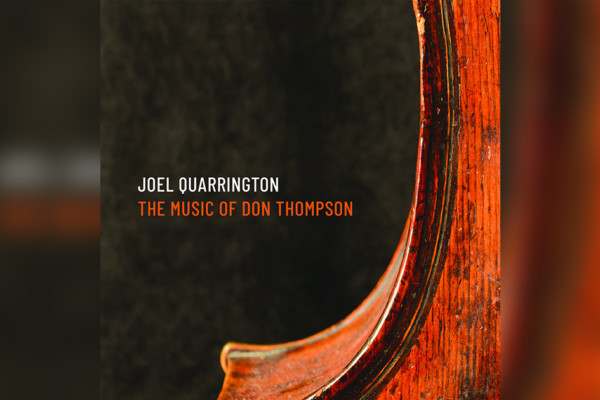
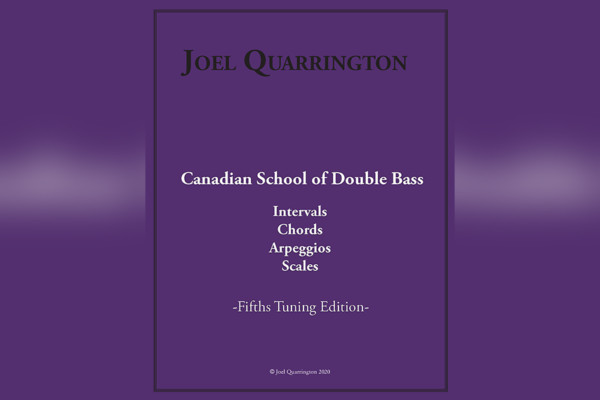
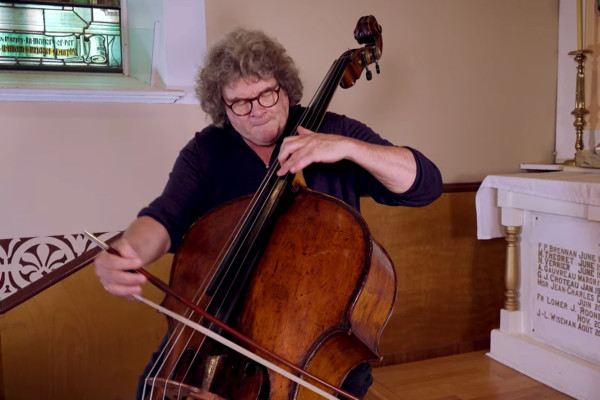
This interview is inspiring. There is so much musicians can achieve if they dedicate themselves to continued learning as Joel has done.